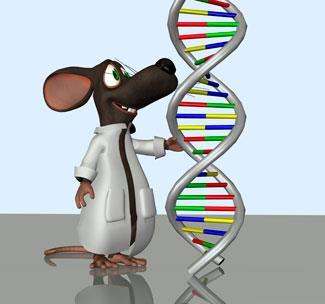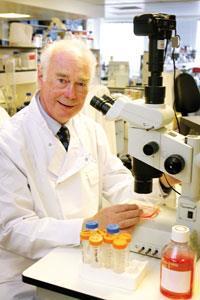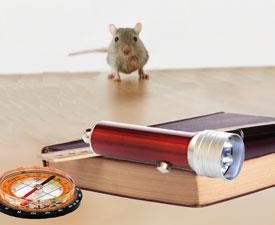2009 marked the first year that more genetically modified animals were used in UK scientific procedures than animals deemed 'genetically normal'. Katrina Megget investigates
2009 marked the first year that more genetically modified animals were used in UK scientific procedures than animals deemed ’genetically normal’. Katrina Megget investigates
The year 2000 wasn’t just the start of a new millennium. It also ushered in a new scientific battle - understanding the molecular roles of the 20-25 000 genes that comprise the human genome. Fast forward almost a decade after the draft human genetic blueprint was published and this battle is in full swing. Indeed, genetic research has become so pivotal in science that 2009 marked the first year that more genetically modified animals were used in scientific procedures than animals deemed ’genetically normal’ - of the more than 3.6 million procedures, just 48 per cent involved animals with a normal genome.

It’s not a complete surprise - use of GM animals has been on the rise since 2000 when the initial results of the Human Genome Project saw the focus of disease really tune in to the molecular level. For many in the area, it was only a matter of time before GM animals overtook their unadulterated counterparts. And similar shifts are being seen outside the UK. But what has the engineered version got that the untampered form hasn’t? And why is the GM variety seemingly becoming the version of choice?
For starters, there is a numerical misconception in how animals in scientific procedures are counted; the vast majority are used for breeding. ’Just breeding a GM animal - even if it is not used in any other regulated procedures - is counted as an animal procedure in UK legislation’, explains Simon Festing, chief executive of pro-research organisation Understanding Animal Research. Establishing and maintaining a new genetic alteration in an animal population takes several breeding procedures. They then need to be continuously bred to provide subject animals for experiments.
According to the UK Home Office, animals are used in six areas of research and testing. In 2009, 42 per cent were used for breeding, 32 per cent for fundamental biological and medical research, 22 per cent for developing new disease treatments, 2 per cent for safety testing non-medical products, less than 2 per cent in developing new methods of diagnosis, and less than 1 per cent for education and training. For genetically modified animals, the bulk of the increase seen in 2009 was down to breeding, which was 10 per cent up on 2008 levels.
Why bother?
GM animals aren’t bred just for the sake of it. And they aren’t used because they are cheap or convenient - one GM mouse can cost anywhere between ?30 and ?100, while a genetically normal mouse comes in at just ?3. The point most scientists make is that, with GM animals, it’s all about the genes and the insights they can provide. Animal research in general has made a major contribution to advances in medicine, and continues to do so. But Festing says genetic modification now provides a whole new playing field. ’GM animals have an important role to play in understanding and treating the more complex medical problems we now face’. Whether it’s a ’knockout’ model - deleting or silencing genes - purposely mutating a gene, or introducing foreign genetic material, the premise is that more can be understood about a disease, its physiological pathway and progression when investigated at this molecular level. It’s an advantage non-modified animals can’t provide.
And with up to 25 000 genes in the human genome to decipher, that’s a lot to understand. But just understanding the genes is no longer enough. Now GM animals are increasingly being engineered as ’models’ of human disease states. There are currently more than 500 genetically modified mouse models of human diseases according to animalresearch.info - an information website run by an international team of researchers to present current consensus on animal research.
For some in this area, this science signals a move to more targeted therapies that revolve around a gene’s role in disease - such as the breast cancer drug, Herceptin (trastuzumab) - and in turn, more effective drugs in the future. Already advances are being seen, says Festing. ’GM mouse technology has been used recently to: create a new model of Parkinson’s disease, which may replace some research using monkeys; study a new compound that may halt Alzheimer’s disease; discover genetic similarities between prostate cancer and hereditary breast cancer; reveal processes that limit excessive scarring and could be used to prevent it; and develop a new gene therapy to treat the most severe type of muscular dystrophy.’
Drug giant GlaxoSmithKline, for example, is using genetically modified mice in obesity research. The company has produced a transgenic mouse that overexpresses the human mitochondrial transporter protein ’uncoupling protein-3’ (UCP-3) in skeletal muscle. Research found that the transgenic mice ate more than the wild-type counterparts, yet remained leaner and lighter. They also showed lower glucose and insulin levels and increased glucose clearance rate. It is hoped that from this research compounds that regulate the expression of UCP-3 might potentially treat obesity in the future.
Meanwhile, researchers in Canada and Brazil have used genetically modified mice to reveal a previously unidentified mechanism contributing to heart failure. The mouse line had originally been engineered with a decreased secretion of neurotransmitter acetylcholine to study neuronal function, but over time the mice developed symptoms similar to heart failure in humans. ’There are other mouse and rat models of heart failure, but what we haven’t had before is a model where we specifically target this chemical messenger acetylcholine,’ Marco Prado from the University of Western Ontario, Canada, said in a statement. Already the team is looking at possibilities of how to treat the disease by increasing acetylcholine levels.
Diabetic pigs

It’s not just mice that are being used to model and research human disease. Pigs have a similar metabolism and physiology to humans, and in Germany, a team from Ludwig Maximilian’s University (LMU) in Munich has used this to create four different genetically modified pig models that develop the symptoms of type 2 diabetes. The GIPdn pig - based on the receptor for the incretin hormone GIP (glucose-dependent insulin-releasing polypeptide) and the only model of the four so far published - has a partially defective receptor, causing a weak response to the hormone. This pig is currently being used for metabolomic studies and for treatment studies with incretin hormone GLP-1 (glucagon-like peptide 1) receptor agonists.
Eckhard Wolf from the Gene Center at LMU says animal models of diabetes are vital for understanding the disease and for developing new therapies. ’It has been possible without genetic modification, since there are diabetes models originating by spontaneous mutations,’ he says. ’The advantage of genetic modification is that the approach is more targeted and is also suitable to mimic human disease mechanisms at the molecular level. We believe that the pig, and especially the tailored pig produced by GM, will represent an important link between the findings in rodent models and their translation into human therapies.’
Andy Greenfield, from the Medical Research Council’s Mammalian Genetics Unit in Harwell, UK, says that now, with the technologies and infrastructure available, ’this [genetic research] is a logical progression of study with an obvious biomedical objective’. Indeed, GlaxoSmithKline says on its website: ’Without [genetically modified animals], the pharmaceutical industry’s ability to discover new treatments would be significantly reduced.’
Genetic modification in a nutshell
British scientist Martin Evans set the genetic modification ball rolling in 1981 when he genetically altered embryonic stem cells from mouse embryos. These produced mice that passed on altered genes to their progeny. By the 1990s this technique was being employed to produce knockout mice to study physiology. The next wave of genetic research occurred in 2002 when the mouse genome was published. About 99 per cent of human genes have a mouse equivalent, there are similarities in gene expression and mice suffer from many of the same diseases. This has meant that mice have quickly become the favoured animal for genetic research, and proved to be useful models of human disease.

There are two main kinds of genetically modified mice used for research - called transgenic and ’knockout’ mice. Transgenic mice contain foreign DNA, which could be human or from another animal. Generally the foreign DNA will produce a new protein, but it may also prevent production of a particular protein or interfere with a biochemical pathway. A common example of a transgenic mouse is the oncomouse, which has an inactivated oncogene making it predisposed to cancer. Knockout mice have a particular gene removed or inactivated to help determine function of that gene. The gene is usually altered by replacing it with a similar but mutated sequence.
A blinkered view?
Greenfield’s statement is all very well considering the world faces an ageing population and hefty chronic disease burden, but are we becoming fixated by genetically modified animals? One person who believes so is Helen Wallace, director of GeneWatch UK, a not-for-profit group that monitors genetic science and technologies. She says science has become ’genocentric’: ’One big problem with using GM animals is the underlying assumption that the causes of disease are primarily biological and that understanding the genetics of complex disease is the solution to a diverse range of problems: cancer, heart disease, deafness, obesity and so on.’
Sebastien Farnaud, science director at the Dr Hadwen Trust - a non-animal research charity - agrees, saying ’many within the scientific community, and also the public, are too eager to see genetic engineering as tomorrow’s universal response to every problem of mankind.’ This, he says, is a consequence of the ’gene craze’ that started a few decades ago, where genes were believed to be responsible for practically all ills.
However, as Wallace notes, many diseases can not be defined purely by their genes - environmental aspects such as socio-economic status, pollution, diet and lifestyle are all contributing factors towards the risk of disease. The danger, she says, is that ’scientists are led down a dead end because the decision to focus studies on genetics excludes a much wider range of questions from research’.
Festing disagrees. Even though diseases have an environmental component, it is important to understand the genetic basis of the disease as well. And GM animals, he says, enable scientists to separate the influence of genes from other disease factors. ’It is possible, in an animal, to alter one or two genes against a stable genetic background, while controlling other factors such as diet and environment. This means you can understand the role of specific genes in multifactorial disease and in the internal environment.’
Indeed, much research is already progressing into what has been dubbed the ’envirotype’ (factors external to the organism that affect its observable characteristics, or phenotype) and incorporating this into study design when modelling human disease. For example, the German Mouse Clinic at LMU is exploring the relationship between genes, environment and physical characteristics by analysing phenotype through five environment platforms that have been identified as risk factors in human disease - diet, air quality, stress, exercise and immunity.
Beyond just genes
Including envirotypes into genetic research is one example of how this area is becoming more sophisticated, but there is still the argument that genetically modified animal models will never be ’human enough’ to provide the research insights needed. The mouse model for cystic fibrosis, generated in the early 1990s, is often cited as an example of this. Characterised by lung and pancreatic problems in humans, cystic fibrosis in mice manifests itself in the gut.

But what this highlights is the complexity of genes. And understanding this complexity can only come through further research. ’We are learning about the principles of the genome - not mistaking mice for humans,’ says Greenfield. ’Certainly we are studying distant relatives - and that must be borne in mind - but the data we generate on GM mice are less like a detailed map of the human genome and more like a ruler, compass, dictionary and torch that guide our understanding of what we are looking at when we examine the human genome.’ GM animals don’t tell us exactly how things work in humans, he notes, but they give us a pretty good idea of where to start looking. ’It’s about using animal models to generate not just the answers, but the right questions.’
Where to from here?
Consensus is that the increasing trend in GM animal use will continue and the research will become more sophisticated. As Festing says, ’scientists are continually looking for new and better ways of advancing knowledge and understanding’. Indeed, there are already new molecular genetic techniques being developed that can turn a gene on or off at different times in adult mice. This ’reversibility’ feature aims to control the resulting phenotype. Next generation models are also likely to take into account the genetic variation in humans and other genetic interactions.
While the proportion of procedures using GM animals might have increased, in 2009 the absolute number of animal procedures actually decreased by 1 per cent. Festing says it is possible that developments that provide better animal models of disease may mean that fewer animals, or fewer higher animals such as primates, are needed in the future. ’For instance,’ he says, ’a triple transgenic mouse can be a better model for Alzheimer’s than an ageing primate. Using genetically modified mice instead of primates to test polio vaccine potency is another example of partial replacement’.
Genetic science is heralding new understandings, and GM animals are the gateway to that. In 2007, the Nobel prize in physiology or medicine was awarded to the creators of the first knockout mouse. In the words of the Nobel Assembly in awarding the prize: ’Its benefits to mankind will continue to increase over many years to come’.
Katrina Megget is a freelance science writer based in London, UK






No comments yet